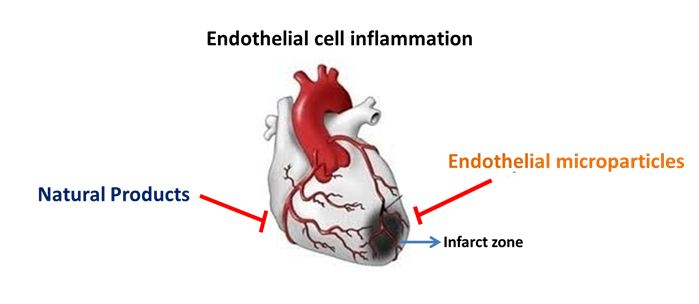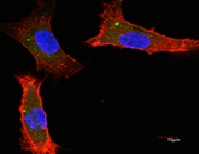Endothelial microparticle mediated signalling
Endothelial microparticles (EMP) are membrane vesicles, shed by endothelial cells by various stimuli due to overt cellular activation by various cytokines or during apoptosis. The protein content or the cargo carried by the EMP highly depend on the stimuli. EMP are known to enclose cyotosolic fractions, cytoskeleton, and nuclear materials such as DNA, RNA, miRNA. These are characterized by the presence of the endothelial markers and known to play a vital role on several aspects of vascular biology such as thrombosis, inflammation, atherosclerosis and angiogenesis. But, the molecular mechanisms controlling the EMP release has not been explored much. In our laboratory, we are basically focusing on the mechanism of EMP release during inflammatory condition and its uptake by the endothelial cells and hence forth the changes that are taking place at the molecular level and even their effect on remodeling the vasculature in vivo. Furthermore, we are trying to explore the contents of the EMPs which are responsible to carry out such drastic change to the endothelium which leads to processes like vascular remodeling.

During the cell death or injury, the endogenous Damage associated molecular patterns (DAMPs, innate protein) molecules are released from stressed cells to amplify the inflammatory responses. Among these DAMPs, High mobility group box 1 (HMGB1) is a highly studied, non-histone nuclear protein, and known to activate inflammatory cells when released extracellularly through pathogen recognition receptors. HMGB1 redistribution and localization is controlled, in part, by post-translational modifications, contributing to the dynamic regulation of HMGB1. we have explored the role of post-translational modification in endothelial cell induced inflammatory process.
DAMPs associated Hepatic injury
Nonalcoholic fatty liver disease results from the excess fat stored in your liver not due heavy alcohol use. Epidemiological studies suggest the prevalence of NAFLD is around 9% to 32% of general population in India with higher prevalence in those with overweight or obesity and those with diabetes or prediabetes. There are currently no non-invasive techniques/biomarkers to confirm NAFLD. No single therapy for NAFLD has been clearly proven to be effective and currently there is no remedy. Various treatment modalities used for NAFLD have included lifestyle modifications such as weight loss and exercise, lowering blood lipid- glucose etc, but none has proved to be effective. To understand the disease progression, we study how the damaged hepatocytes induce the inflammatory responses, angiogenesis and other processes resulting in the further aggravation of the disease.
 Fig: Endothelial cells forming tubules
Fig: Endothelial cells forming tubules
 Fig: Showing F-actin staining
Fig: Showing F-actin staining
 Fig Showing microCT image of mouse liver vasculature
Fig Showing microCT image of mouse liver vasculature
➤ Screening of novel anti-angiogenic compounds
➤ Screening of novel compounds to alleviate NAFLD
Regulatory Safety Pharmacology
➤ Assessing the QT prolongation for different drugs in rodents as a preclinical safety following ICH, S7A guidelines, OECD principles and Good laboratory practices.